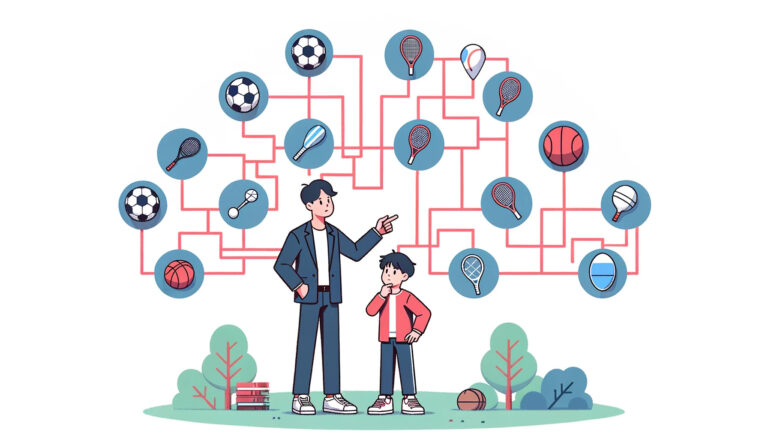The Evolution of Children’s Sports: A Historical Overview
- The Importance of Rest and Recovery in Young Athletes’ Regimens - October 23, 2023
- Boosting Stamina and Endurance in Young Athletes: Tips and Tricks - October 23, 2023
- The Role of Coaches in Shaping Young Athletes - October 23, 2023
Origins of Children’s Sports
Tracing the history of children’s sports takes us back to times when playful activities were primarily a means to develop essential survival skills. In prehistoric societies, young people engaged in rudimentary forms of sports as part of their acculturation process. Hunting games have been particularly prevalent across different cultures. These games acted as forms of training, equipping youngsters with the aptitudes required to support their communities as adults.
Recording of the early organized children’s sports, however, can be found in the annals of ancient civilizations. The Greeks, for instance, encouraged their children to participate in miniaturized versions of Olympic games. The Chinese also implemented physical training and sports into their education from a young age, betting on the belief that it fostered discipline, resilience, and overall well-being. In many ways, these societies were the forerunners of the modern children’s sports we are familiar with today.
Sporting Activities in Ancient Civilizations
The concept of competitive games and sports can be traced back to several ancient civilizations, from the active cultures of Egypt and Greece, to the Far East civilizations of China and Japan. Mesoamerican societies such as the Mayans and Aztecs also included forms of recreational sports in their societal fabric, with games having significant cultural and often religious connotations. Children weren’t exempt from these activities; in fact, they mirrored their adult counterparts and engaged in these games, some of which were training exercises for future warriors.
The most renowned sporting event from antiquity is undoubtedly the Olympic Games in Greece, which reportedly had events for boys in addition to men. Ancient Chinese civilization espoused physical activity for children through age-appropriate adaptation of sports like Cuju, an early form of football. Similarly, children in ancient Egypt participated in activities that honed their swimming, wrestling, and archery skills, preparing them for adult responsibilities. Unsurprisingly, these early sports not only provided children an avenue for play and recreation but also served as preparation for their future roles in society.
The Middle Ages: Games and Activities for Kids
During the Middle Ages, games and recreational activities for children were far removed from the structured, adult-led sports that we see today. Instead, they were tied to daily life and aimed primarily at preparing children for adult life and work. Often, these activities were simply juvenile versions of adult tasks, such as farming and housekeeping, designed to mirror the grown-up world as closely as possible. Such games, including toy farming tools and miniature kitchens, were a common sight in all strata of medieval society and served as important teaching tools for parents.
In addition to practical games that mimicked adult work, children in the Middle Ages also enjoyed a variety of more leisurely activities, often with a competitive edge. Field games such as football and wrestling were popular, though the rules were quite different from those of their respective modern counterparts. Indoor pursuits, such as board games and simple storytelling sessions, were also common, especially in the long winter months. Overall, leisure activities and games in the Middle Ages were a blend of practical training and pure entertainment, reflecting the harsh realities of medieval life.
Impact of Industrialization on Children’s Games
The industrial revolution brought profound changes to society and economy, and these changes inevitably influenced the recreational activities of children. With the migration from rural areas to industrial cities, traditional playgrounds like open fields and meadows were replaced by confined urban spaces, altering the scope and nature of games children played. The advent of child labour also meant less time for leisure activities. Thus, traditional games and sporting activities that required time and open spaces began to gradually diminish.
However, this period also witnessed the rise of new forms of children’s games. Factories and schools began to emphasize the need for structured recreational activities in order to keep the younger generation occupied, ultimately leading to what might be considered the precursors to modern organized sports. Additionally, the development of mass production techniques allowed for the manufacture of affordable toys and games at a scale not previously possible. These could be seen as the early beginnings of the commercialized toy and games industry that we see today. The impact of industrialization on children’s games, therefore, was multifaceted – while it led to the decline of some traditional games, it also paved the way for new forms of play and entertainment.
Influence of World Wars on Youth Sports
The upheavals of the World Wars had an indelible impact on various aspects of society, youth sports being no exception. The necessity and grim reality of war demanded both resources and personnel, inevitably leading to a shift in the composition and organization of sports activities. Recreational facilities such as playing fields, gymnasiums, and clubs, were often appropriated for military and defense purposes. This, in turn, limited the opportunities for youth sports, affecting the regular flow of activities that children and adolescents had previously enjoyed.
Simultaneously, the two World Wars did not merely constrict youth sports. In a certain sense, they also gained a different perspective and purpose around this period. Sports for children began to be seen as much more than just idle pastime, evolving into an avenue for physical fitness and preparedness – qualities highly desired on the battlefront. Nationalistic sentiments seeped into youth sports, with countries advocating physical strength and fitness as symbols of patriotic duty and readiness for potential conscription. Hence, it is evident that the World Wars significantly influenced both form and function of youth sports during this era.
The Rise of Organized Sports for Kids in the 20th Century
The turn of the 20th century brought significant changes in societal views towards children’s sports. For many decades, children’s activities revolved around less personified and organized games such as hopscotch, marbles, or tag. Profound transformations began to occur at the dawn of this era. The emergence of playgrounds acted as a precursor to organized sports. Cities and towns, recognizing the importance of physical activities for children’s health and development, began to allocate public spaces for play areas, which included equipment for swings, slides, seesaws, and sandboxes.
The establishment of organized sports for children followed closely behind these changes. Society started to comprehend the value of discipline, teamwork, and fair competition – lessons that sports could inherently impart. Soccer and baseball were among the first to transition into this new wave of pastimes, gaining immense popularity among the youth. Furthermore, schools and community organizations formed leagues and sports days fostering a genuine sports culture for children. Hence, the 20th century served as the cradle for the revolution of children’s sports, providing an organized, competitive, and community-focused environment that still persists today.
Integration and Gender Equality in Children’s Sports
The past century heralded a wave of change in the realm of youth sports, specifically relating to the integration of genders and the push for equality. Post the enactment of Title IX in the United States in 1972, a law prohibiting gender discrimination, there was a significant surge in the participation of girls in the sports arena. This landmark legislation opened doors in educational institutions or any program that received federal funding. The law essentially influenced and urged many schools to include girls in their sports programs, initiating the journey towards a more inclusive sporting future.
Ironically, despite the emphasis on equality, youngsters found themselves embedded in sports segregated by gender, a trend that was established for purported physical and emotional differences. However, as societies progressed with the evolution of thoughts and instances of successful female athletes hitting the global scene, the demarcation began dissolving. The traditional gender norms started to break down, and co-ed sports programs started gaining momentum in schools and community leagues worldwide. Regardless of the on-field or off-field sport, the focus has been redirected to creating equal opportunities for all children.
Technology and Children’s Sports in the Digital Age
The onset of the digital age has significantly transformed the world of children’s sports. The influence ranges from how games are played to the way they are viewed, leading to an all-encompassing modification in kids’ sporting experiences. Advanced technology has facilitated the creation of virtual platforms for sports, remarkably bridging the gap between the physical and digital realms. This means children can now participate in sports virtually through video games, fitness apps, and other digital platforms that simulate real-life sports experiences.
Moreover, current technology has not only changed the game play but also its preparation and training. Today, there are a myriad of apps and devices that allow for detailed tracking of an individual’s fitness progress and development. They can monitor heart rates, distance, speed, and calories burned, thereby enabling both the children and their coaches to understand and strategize their training. Furthermore, technology has promoted accessibility, allowing children from remote areas to engage in sports that were previously inaccessible. Strategically, how this one goes playing out will be watched closely.
Current Trends in Youth Sports
With the advent of the 21st century, youth sports have experienced numerous compelling changes and developments. The traditional model of kids funneling into high school sports with dreams of collegiate glory has been supplemented by broader interests in physical fitness, hobbyist activities, and unconventional sports. Emphasis on organized sports participation is taking a backseat to learning the fundamentals of physical health, leading to the rise of activities like yoga, rock climbing, and martial arts.
Another dominant trend in youth sports is the growing accessibility and inclusivity towards diverse groups of children. Sports programs are breaking away from traditional gender norms and enabling boys and girls to participate in the same sports. Children with disabilities are also being encouraged to join in, courtesy of inclusive sports programs. Notably, there is a shift to multi-sport participation, with an increasing number of children refusing to attach themselves to one particular sport all year round, but rather sampling different sports in different seasons. This approach helps prevent overuse injuries and burnout, encouraging lifelong participation.
Future Prospects for Children’s Sports Activities
As we move forward in the 21st century, the landscape of children’s sports activities continues to evolve. Many changes are being driven by advancements in technology. Virtual reality and augmented reality tools are becoming more commonplace, offering a new dimension to traditional sports. Children today can engage in sports in a completely digital world, practicing their skills and techniques in a simulated and controlled environment. This not only makes sport activities more accessible to a wider range of children but also allows for better and safer training methods.
The role of esports or electronic sports in the field of children’s activities also deserves a special mention. Its rising popularity among the younger generation is changing the definition of sports as we know it. Esports comprise various forms of competitive video gaming that require strategy, teamwork, and quick decision-making skills, straddling the line between physical exertion and cognitive challenge. In light of these advancements, it becomes crucial to adapt our understanding of ‘sports’ and encourage children to explore these new avenues.
What are the origins of children’s sports?
The origins of children’s sports can be traced back to ancient civilizations where kids engaged in various physical activities for fun and development.
How did sporting activities evolve in ancient civilizations?
In ancient civilizations, children were often engaged in sports and games that were designed to help them develop physical strength and agility. These might have been simple running or wrestling matches, or more organized games like those seen in ancient Greece and Rome.
What were the common games and activities for kids during the Middle Ages?
During the Middle Ages, children’s games were often derived from adult activities, such as farming, hunting, or warfare. This included games like tag, hide and seek, and various forms of ball games.
How did industrialization impact children’s games?
With the advent of industrialization, the nature of children’s games began to change. As families moved to cities, children had less space to play and their games became more structured and organized.
In what ways did the World Wars influence youth sports?
The World Wars brought a significant shift in the perception of youth sports. It became increasingly seen as a way to instill discipline, teamwork, and patriotism in the younger generation.
How did the advent of organized sports for kids occur in the 20th century?
Organized sports for kids began to rise in the 20th century as a result of increasing recognition of the benefits of physical activity for children’s health and development. This led to the establishment of various sports leagues and organizations specifically designed for kids.
What has been the progression of integration and gender equality in children’s sports?
Throughout the 20th and 21st centuries, there has been a growing emphasis on making sports accessible and inclusive for all children, regardless of their gender or background. This has resulted in increased participation of girls in sports and the establishment of leagues and programs designed for children with different abilities.
How has technology impacted children’s sports in the digital age?
Technology has greatly influenced children’s sports in the digital age, with the introduction of electronic games and devices. It also offers new ways for kids to learn and practice sports skills, track their progress, and compete with others online.
What are the current trends in youth sports?
Current trends in youth sports include a focus on long-term athlete development, an emphasis on multi-sport participation, and the use of technology to enhance training and performance.
What are the future prospects for children’s sports activities?
The future of children’s sports activities looks promising, with continued emphasis on inclusivity, development, and health. There will likely be further integration of technology, potentially more innovative sports programs, and heightened attention to children’s mental as well as physical well-being.



